Aprilia RS 457 vs KTM RC 390 comparison review
The KTM RC 390 has been the go-to made-in-India sportbike for the last decade but all that might be about to change with the advent of the Aprilia RS 457.
Published on Apr 14, 2024 07:30:00 AM
61,527 Views
Follow us on
This story comes from the exciting new CoASTT High Performance Centre in Coimbatore. We were there for the annual Autocar track day and since both these bikes were a part of that story, we really couldn’t resist sharing a quick comparison with you as well. After all, these are the two most sporty track-oriented motorcycles that are currently manufactured in India. This is not a story of comfort, practicality, or anything as mundane as that – those are all evaluations for a later date. Today, we answer just one question – which bike can lap the track faster?
ONE, TWO PUNCH
The odds are certainly in Aprilia’s favour. It has a 457cc parallel-twin motor that not only makes a great sound but also kicks out 47.6hp and 43.5Nm of torque. In comparison, the RC 390 uses KTM’s previous-gen 373cc single-cylinder motor that makes 43.5 horsepower and 38Nm of torque. Both engines have a rev limit just over 10,000rpm and both also have six-speed gearboxes. However, only the KTM comes with a bi-directional quickshifter as standard; Aprilia will sell you theirs as an accessory and we don’t know the price yet.
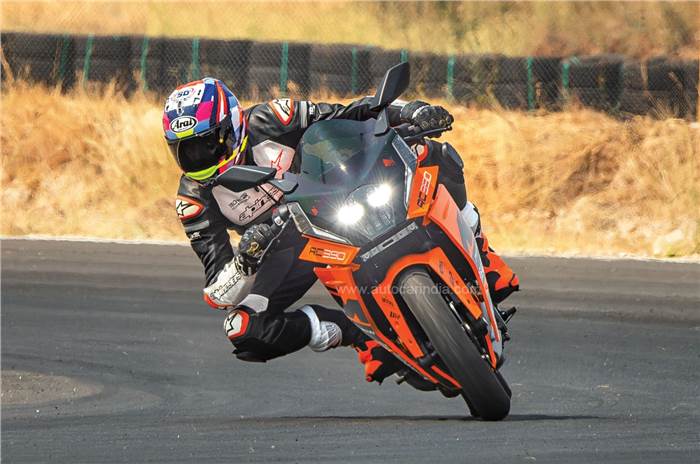
On track, it came as no surprise that the Aprilia feels like the quicker bike. But what was interesting was the difference in how the two engines deliver their power. CoASTT is an extremely fast and flowing circuit, and you really have to work the engines hard on relatively small-capacity motorcycles like these, especially through the long uphill corner complex.
That’s where the Aprilia’s stronger torque and mid range comes into effect. You can hold a higher gear in some corners and it doesn’t punish you as much if you drop out of the top four thousand revs. That being said, this engine doesn’t have a lot of zing in the very last 1,000rpm below the redline.
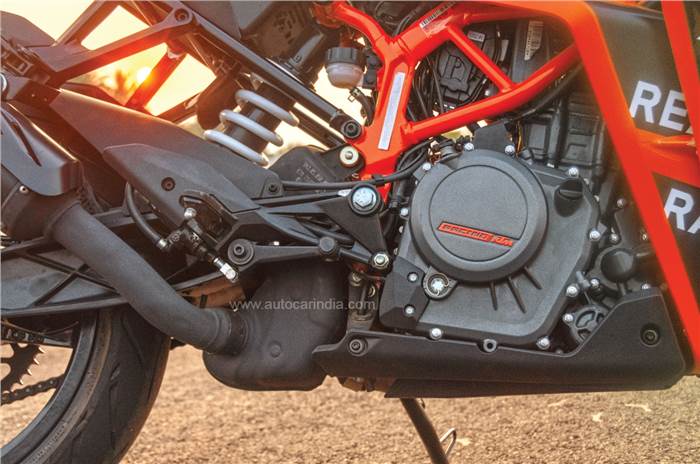
The KTM engine is different. This motor has a more voracious appetite for revs and in this environment, it punishes you if you drop below 6,000rpm. You have to keep it in the right gear and you have to keep the revs up. In that sense, the Aprilia is easier because you could use the torque and ride around some of these corners in a higher gear than you would on the KTM.
FRAMEWORK
Both take different approaches to the chassis as well. On the KTM, you have the trademark tubular steel trellis frame and cast aluminium swingarm. The Aprilia, meanwhile, debuts the first superbike-style aluminium perimeter frame on a locally manufactured motorcycle, but it uses a steel swingarm.
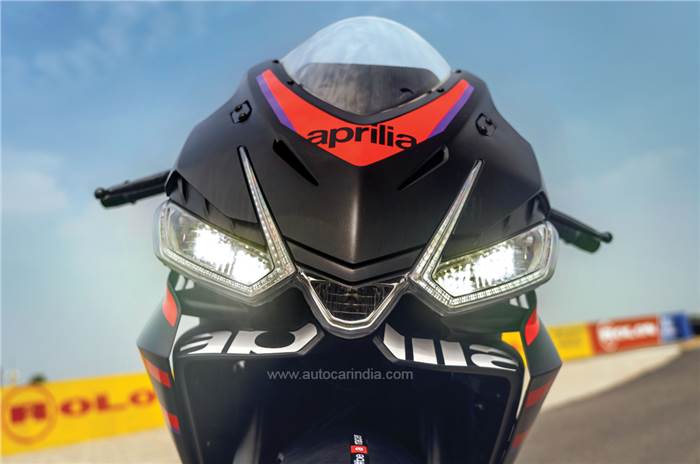
In terms of rider assists, both bikes have traction control and switchable ABS, but the Aprilia’s systems are more tunable and a little less intrusive when you’re on track.
As for the ergonomics, the KTM is the more roomy motorcycle. For tall riders, this is nicer as there’s more space to scooch back when you’re crouching down; the clip-on bars are wider as well. The Aprilia is not terribly cramped and even tall riders will fit on it, but it does feel tighter overall. However, the Aprilia’s wider fuel tank was nicer to hold onto with the thighs at big lean angles and the KTM fuel tank’s shape never felt as accommodating.
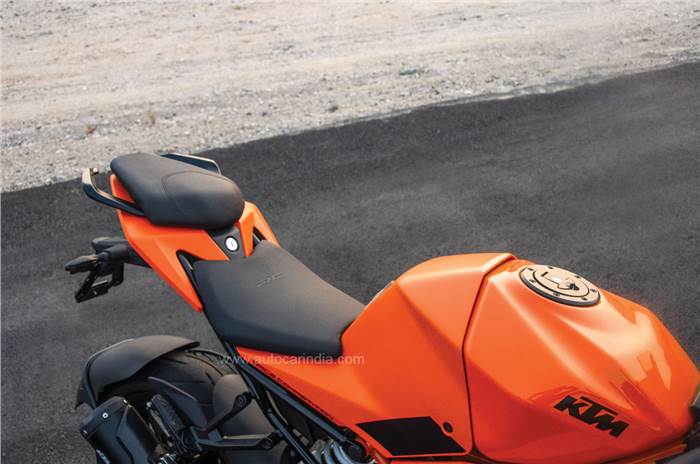
On track, what stood out to me was the fact that the KTM felt more stable and a little more confidence inspiring, despite taking more effort to change direction through some of the more tricky sections. For example, this race track is not fully ready yet – the kerbs haven’t yet been installed and there were some rough and slightly loose patches of tarmac at some corner apexes. I felt a little more secure on the KTM through these loose surfaces when the bike was leaned over.
The reason for that is that the Aprilia is the sharper handling machine. It turns quicker, takes less effort to turn and is willing to lean right over more quickly. This is a big statement to make, but the Aprilia is a more sporty-feeling machine than the KTM, albeit by a small margin.

Something else that’s interesting is that even though the Aprilia looks bigger and bulkier with its chunky fuel tank, it actually feels a little more compact and lighter on its feet. This is unusual given that the RS 457 actually weighs 3 kilos more, but I think some of that comes down to the more aggressive profile of the excellent TVS Eurogrip Pro Torq Extreme tyres. The H-rated Metzeler M5 Sportec tyres on the KTM are good up to a certain point, and they’re better at track pace.
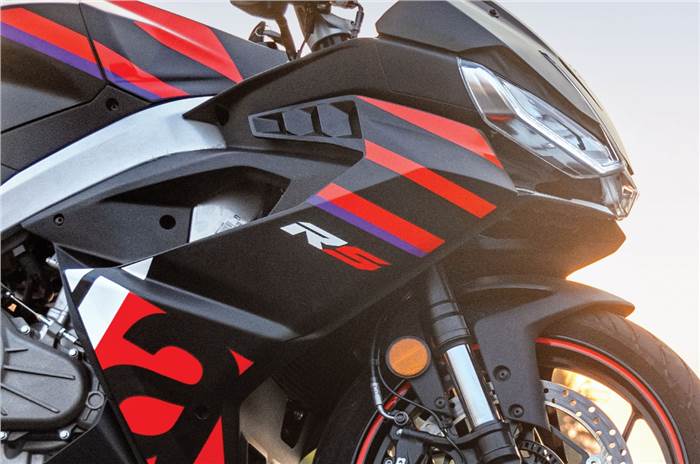
As far as braking goes, neither bike is spectacular, but both are good enough. It’s worth pointing out that the CoASTT circuit doesn’t have multiple, repeated, hard-braking zones so we didn’t face the brake fade issues that the Aprilia exhibited at the first ride review on the Kari Motor Speedway.
AGAINST THE CLOCK
Now it’s one thing to talk about how these bikes feel on the race track, but the real answer comes in the lap times. And for that, we have someone way faster and more talented than I am to push these bikes to the limit – 11-time national champion Rajini Krishnan.
To cut a long story short, the RS 457 was 4.5 seconds quicker than the RC 390. In fact, it also went about 4s quicker than the all-new 390 Duke with its brand new chassis and larger 399cc engine. Clearly then, this is now the fastest way to get around a race track for less than Rs 5 lakh.

Speaking of, while the Aprilia costs about Rs 90,000 more than the KTM, it is also a step ahead in terms of performance and also packs a much more premium-feeling twin-cylinder engine. And it also happens to make a great sound in the process. In fact, for some riders, the RS 457’s deep exhaust growl alone will be worth the extra money.
So there you have it. The Aprilia rules on the race track – now we need to see just how good it is on the road. That’s a story for next month!
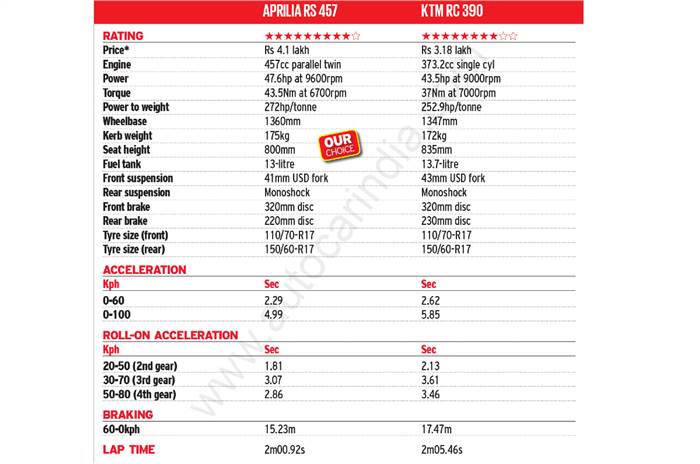
Copyright (c) Autocar India. All rights reserved.
















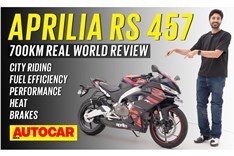



Comments
Member Login
Personal Details
No comments yet. Be the first to comment.